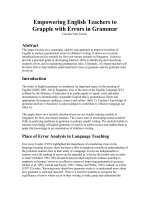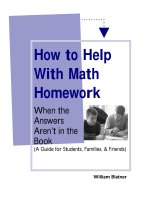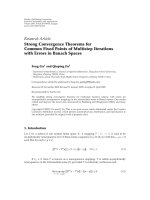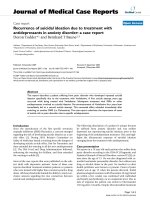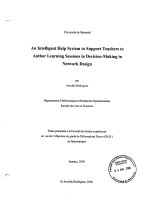Empowering English Teachers to Grapple with Errors in Grammar
Bạn đang xem bản rút gọn của tài liệu. Xem và tải ngay bản đầy đủ của tài liệu tại đây (96.76 KB, 7 trang )
Empowering English Teachers to Grapple
with Errors in Grammar
Caroline Mei Lin Ho
Abstract
This paper focuses on a systematic, step-by step approach to empower teachers of English
to analyse grammatical errors in children's writing. It draws on a recently introduced pre-
service module for first year trainee teachers in Singapore. It aims to provide a practical
guide in developing teachers' skills in identifying and classifying students' errors, and in
explaining grammatical rules. Ultimately, it is hoped teachers will be better able to help
students understand their errors in grammar and the grammar rules involved.
Introduction
The study of English grammar is considered 'an important aspect in the learning of English'
(MOE 2001: 64) in Singapore. One of the aims of the English Language (EL) syllabus by
the Ministry of Education is to enable pupils to 'speak, write and make presentations in
internationally acceptable English that is grammatical, fluent and appropriate for purpose,
audience, context and culture' (ibid: 3). Teachers' 'knowledge of grammar and how it
functions' is acknowledged to contribute to 'effective language use' (ibid: 6).
This paper draws on a recently introduced pre-service teacher training module in Singapore
for first year trainee teachers. The course aims at developing trainee teachers' skills in
analyzing problems in grammar in primary pupils' writing. The module builds on trainees'
knowledge of English grammar covered in an earlier course and enables them to apply this
knowledge to an examination of children's writing.
Place of Error Analysis in Language Teaching
Ever since Corder (1967) highlighted the importance of considering errors in the language
learning process, there has been a shift in emphasis towards an understanding of the
problems learners face in their study of a language. Errors are indispensable to learners
since the making of errors can be regarded as 'a device the learner uses in order to learn'
(Selinker 1992:150). Research has provided empirical evidence pointing to emphasis on
learners' errors as an effective means of improving grammatical accuracy (White et al,
1991; Carroll and Swain, 1993; Trahey and White, 1993). Indeed, as Carter (1997:35)
notes, 'Knowing more about how grammar works is to understand more about how
grammar is used and misused'. There is a need for students to recognise the significance of
errors which occur in their writing, to fully grasp and understand the nature of the errors
made. This requires English language teachers to be better equipped, more sensitive and
aware of the difficulties students face with regard to grammar.
This article distinguishes 'mistakes' from 'errors' where the former refers to unsystematic
errors of learners as opposed to the systematic errors of learners from which we are able to
reconstruct their knowledge of the language to date (Corder, 1978). The underlying
assumption is that students' errors made in grammar are systematic and classifiable.
Attention to error type and an understanding of the violation or misuse of specific grammar
rules offers teachers a means of helping students deal with language and usage problems.
Then only can students be sensitized to specific problems they may have, and to recognize
and remedy these problems.
An Approach for Error Identification and Analysis
A 3-step approach designed by the author is adopted to enable identification and analysis of
students' errors. The following outlines the steps involved with the use of a table (Appendix
1):
1. Where is the problem? - Identification of error
Write out sentence containing the error. Underline/Highlight word/phrase/clause which
shows the error.
• Eg He are hungry.
Use caret ^ to indicate omissions (if any).
• Eg He hit ^ car (omission of article 'a').
2. What is the type of problem? - Definition and classification of error
a) State type of error
(eg Part of speech : eg Verb, Article, Noun, Adjective, Adverb, Preposition).
b) Classify error type
(eg Omission, Over-generalisation, Wrong combination).
• Eg. He are hungry.
Error identified Definition of error type Classification of error type
He are hungry. Verb Wrong combination of subject and verb.
3. How can you explain the problem? - Explanation of rule and
exemplification
a) State the grammar rule which has been violated.
(eg. Singular subject 'He' must take a singular verb 'is'.)
b) Give correct form to show contrast with inappropriate/deviated form.
• He is hungry.
c) Give Examples Showing the Rule in Action
• She is tired.
Guiding Teachers in Adopting the Approach
To aid teachers in defining the error type, a list of suggested terms was provided:
Definition of Error Type
• Noun
• Pronoun
• Verb
• Conjunction
• Adjective
• Adverb
• Preposition
• Article
• Determiner
The term 'Sentence structure' was included for errors pertaining to sentence construction,
for example, if a sentence is incomplete or fragmented:
• eg. Although it was raining. The boys continued playing in the field.
The classification of error type was narrowed to the use of the following terms (Appendix 2
for examples):
• Omissions
• Additions
o Over-/Double marking
o Overgeneralisation
o Unnecessary insertion
• Wrong or Inappropriate Combination
• Inappropriate construction
• Misordering or Inversion
Where the explanation of rules is concerned, trainees are taught to state the rules clearly
and simply. The following are examples:
• The noun 'luggage' is uncountable and is always in the singular form; thus,
'luggages' is unacceptable.
• A verb following the modal verb ' should' is in the base form; hence, 'should train'
is acceptable but not ' should trained'.
• The subordinate clause 'Although it is raining' is dependent on the main clause and
cannot stand on its own. Thus, 'Although it was raining, they continued playing' is a
complete sentence but 'Although it was raining' is incomplete by itself.
Applying the Approach to Sample Errors in Students'
Writing
The following examples illustrate the use of the approach to deal with various errors in
grammar:
Identification of
error
Definition and error
classification
Explanation of rule
We put all the
equipments on the
beach.
Noun
Unnecessary insertion of
plural marker -s
'Equipment' is uncountable noun and does
not require the plural marker -s:
'We put all the equipment on the beach.'
A large number of
people is sick.
Verb
Wrong combination of
subject and verb
'A large number' refers to more than one
person, ie plural subject, and requires
plural verb 'are': 'A large number are sick'.
I would appreciate ^
if you could help
me.
Verb
Omission of direct object
'Appreciate'is a transitive verb and
therefore needs an object 'it':
'I would appreciate it if you could help me.
He is owing me ten
dollars.
Verb
Inappropriate verb
construction
'Owe' is a stative verb and does not require
the -ing participle:
He owes me ten dollars.
I don't know why
are we taught this.
Subject-verb order
Misordering/Inversion of
subject and verb
Subject-verb inversion (why are we taught)
in the interrogative but inversion ruled out
in the form of statement (why we are):
I don't know why we are taught this.
While she was
talking. The phone
rang.
Sentence structure
Incomplete/fragmented
clause.
The subordinate clause 'While she was
talking' is dependent on a main clause and
cannot stand on its own. Thus, 'While she
was talking, the phone rang' is a complete
sentence.
Knowledge of grammatical terms such as 'countable/uncountable nouns', 'transitive
/intransitive verbs', 'stative/dynamic verbs', 'main / subordinate clause' enabled trainees to
begin describing and discussing the errors identified. Introduction to basic concepts and
terminology required in a study of English grammar provided the foundation needed before
attempting to identify and analyse errors.
The classification of error type was facilitated by the use of broad terms such as 'omission',
'over-generalization', 'unnecessary insertion' which acted as prompts in guiding trainees to
explain the nature of the errors identified, and to examine closely the error in the context of
the child's text. Trainees commented that the use of these leading prompts gave them the
confidence to begin talking about the errors identified and provided them a sharper focus in
analyzing the errors. What this approach essentially provided was the metalanguage to
enable teachers to explain and describe the nature of errors identified, and also to sharpen
their analytical skills in a closer examination of grammatical problems in children's writing.
Impact on Trainee Teachers
Trainee teachers, in being sensitized to the grammatical problems evident in children's
writing, generally welcomed the close attention to the specifics of identifying, analyzing
and explaining involved. Among the positive responses of trainees in evaluating the course
at the end of the module are the following--
• Identifying, defining and classifying errors:
o 'Table is a very good idea to teach students to identify errors'
o 'Systematic, step-by-step approach'
• Explaining errors:
o 'Know how to explain mistakes made to students'
o 'Useful in a way that the explanations given were clear and precise'
o 'Now I am able to explain the rules of grammar'
o 'Instead of just being able to recognize errors, I am now able to explain the
rules and correct the errors'
• General gains on a personal level:
o 'Learned stuff I never knew'
o 'Improves my command of language'
Among the suggestions for improvement were requests for more time and practice to work
on more samples of texts in order to apply the approach of error identification,
classification and explanation to other types of texts written by children.
The Way Ahead
More time and practice given to trainees in analyzing texts using the approach suggested
would polish up their analytical skills and build their confidence in explaining and
describing the specifics of what is involved in less than perfect grammatical constructions
in children's writing. The need to constantly monitor trainees' own understanding of
specific concepts and rules involved in grammar is also not to be overlooked. Until trainees
themselves are clear as to what grammatical features are in play and how these affect the
comprehensibility or otherwise of students' texts, there is little value in progressing to the
next stage of discussing and explaining the interplay of various grammatical features, let
alone the rules involved. It was also found that having trainees deliberately examine and
articulate what contributes to grammatically flawless constructions by children from time
to time rather than only problematic examples provided a useful contrast whereby major
differences and key flaws in the use and misuse of specific grammatical features can be
highlighted and made more explicit.
The careful attention and close textual analysis of the types of problems children face in
constructing texts essentially works towards resituating grammar within the context of
textual production rather than having grammar focused at the individual level of isolated,
discrete item-testing. Grammatical concepts are taught by providing students adequate
definitions, diverse examples and non-examples carefully discussed in the context of the
children's own use of language. The approach offers an opportunity of exploiting the


